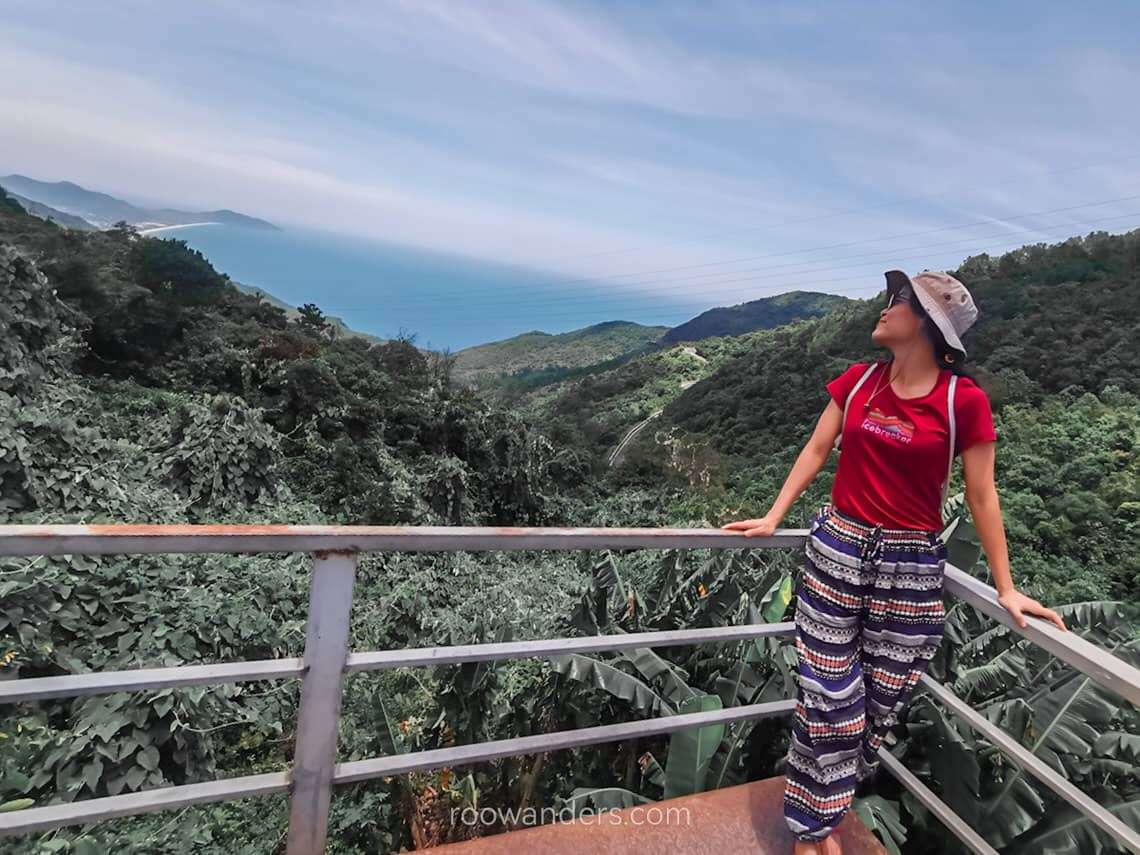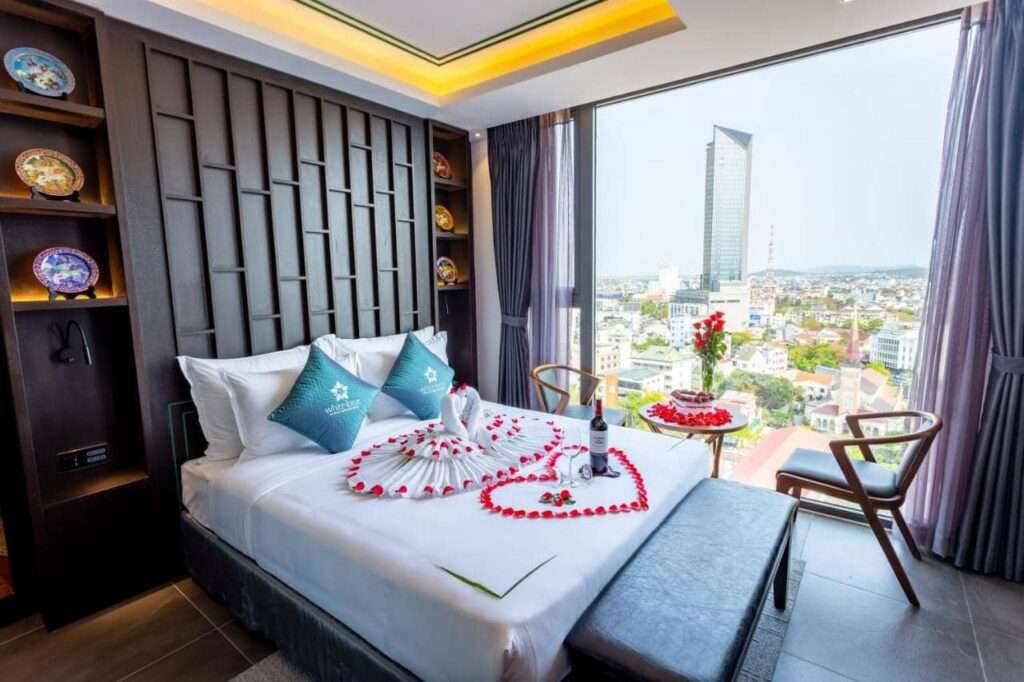
Hai Van Pass: From Hue to Hoi An
The Hai Van Pass is a 21 km road traversing across a mountainous region of Central Vietnam.
Home to breathtaking coastal sights and bendy steep routes, the Hai Van Pass is a splendid road trip linking the two ancient towns of Hue and Hoi An.

I visited Vietnam in August 2023. This post may be updated periodically. Post also contains affiliate links that cost nothing to you but support my blog. Cheers!
What’s so special about Hai Van Pass?
Hai means ocean, and Van means white clouds.
Looking at just the name of the pass tells you a lot about what to expect: (1) It could have been the alluring scenery of mist clinging onto the forested mountains, which befits the name Ocean of White Clouds, or (2) the endless white clouds etched across the sky above the boundless blue ocean.
The second explanation resonates more for my hot August afternoon visit.

Guardian ranked it as one of the 10 great scenic drives ‘you’ve probably never heard of’ in 2015. A US magazine Travel + Leisure named it as the top 4 out of 10 most beautiful coastal drives in the world in 2021 using data collected from Instagram. Granted, lists of such sorts change every year. But having even one of them mentioning Hai Van grants a closer look into this pass.
Hai Van Pass is the highest motorable pass in Central Vietnam at a height of 496 m. It is also one of the most accessible and rideable routes for DIY motorists in Vietnam.
Given its mountainous terrain, Hai Van Pass was once the geopolitical boundary between the Champa and Dai Viet Kingdoms. The steep mountains were also an obstacle during conquests. Fortification and watchtowers on the top of the pass were vital during the Vietnam War.
Where is Hai Van Pass?
Located between Thua Thien Hue province and Da Nang province, Hai Van Pass straddles over the Truong Son Mountain Range, also known as the Annamite Range.
Da Nang City is a mere 30 km or 40 mins car ride from the Hai Van Pass. Hoi An is a further 30 km south of Da Nang.
Most itineraries feature travelling from Hue to Da Nang or Hoi An, or vice versa, with Hai Van Pass being one of the highlights along the way. The entire journey is 130 km. Buffer in a day to include stops and breaks along the way.
How to travel: Modes of transport
There are several ways to travel between Hue and Da Nang. Choose one below depending on your time, your wallet, and your confidence in handling a motorbike.
Motorbike
Travelling via a rented motorbike is definitely the most fun and adventurous way of going over the pass for the licensed and experienced. You get full autonomy over your travels, and the road is in good condition.
But of course you must be confident with riding the curves and hairpin bends, and hold a valid licence. Riding a motorbike without a licence voids your insurance.
I’m no biker, but if you are one, you may find this detailed motorbiking guide by Vietnam Coracle useful in your research.
Easy Rider
Friends who do not have a licence or the confidence to ride a bike but still want the motorbike experience – not to worry. There are plenty of agencies with Easy Riders tours where you hop onto the bike of a guide without the stress of riding the bike.
Sightseeing Bus
For those who don’t intend to be on a motorbike under the poisonous hot August sun, go with a sightseeing bus.
Make sure the bus is a sightseeing bus that goes over the pass and brings you to several other stops. It shouldn’t be a direct bus that only travels on National Road 1 and bypasses the mountain and the pass via a very long – 6.28 km, longest in South East Asia – tunnel.
Car
Hire a private chauffeur and travel in comfort throughout the journey.
Jeep
The coolest mode of transport is probably a private jeep. But not for me if it rains or if the humidity and heat are high.
Train
Taking the Reunification Express Line is another exciting way to enjoy the scenery. The train takes a different route to the road but features many sheer drops, long sharp bends and views of the mountains and untouched coastlines.
One important thing to note: Make sure you’re travelling that stretch during the day and not at night!
Travelling between the twin metropolises of Vietnam by train is a novel adventure. In fact, this train ride is publicised as – we come again – one of the world’s greatest train rides by Lonely Planet. If this excites you, here’s what to expect for a sleeper train experience to get you started.

Best season to travel through the pass
Visit Central Vietnam from February to April during the dry season for less fog and rain.
Anytime between September and November – the peak wet season – is risky to travel, with a high chance of heavy rains and floods. Road conditions may not be suitable during that time. Besides, the wet season is also prone to cyclones and typhoons – you wouldn’t want to be caught in one on a coastal pass. Central Vietnam had one of the worst floods in years in October 2020.
December and January might still see rain from the dwindling rainy season. But this is also the peak holiday season and prices might soar. Book your accommodations and transport or tour tickets early if you’re travelling!
Downsides of travelling from May to August, the dry summer period, include a 35°C – 40°C baking hot sun. My visit in August was so hot I could see heat waves from the tarmac. Our bus had to stop midway up the pass to cool down.
Stops between Hue and Hoi An
Hue
Ancient capital Hue is a city you should dedicate at least a day, better two, to visit the Imperial Citadel, impressive tombs of emperors from the last dynasty, and fill yourself up with good noms.
We stayed in an affordable and highly hospitable boutique in Hue for two nights, and learnt about the travel tour bus from their cute receptionist.

Thanh Toan Bridge
Not many – me included – visitors would have heard of Thanh Toan Bridge in this small town of Huong Thuy.
Located about 6 km southeast of Hue, the town – or rather, village – began as early as the 16th century, even before Thien Mu Pagoda in Hue. According to historical records, a dozen influential families followed Lord Nguyen Hoang – the first lord of the kingdom – to settle near Hue.
Years later, in the late 1770s, a powerful woman of the Tran family decided to build a durable bridge over the river, having seen the daily struggle of the villagers. Lady Tran Thi Dao also donated generously to the village. Emperor Khai Dinh had an altar set up in the middle of the bridge in 1925 to commemorate her.
Apart from marvelling at the intricacies and stories behind the restored bridge, we visited a museum nearby and joined the morning crowd in a market.
The town is said to hold big festivals a couple of times a year to commemorate the Lady Tran Thi Dao, and also welcome Tet.



Lap An Lagoon/ Lang Co Bay
The next destination is a 62 km or slightly over an hour bus ride. Surrounded by the imposing mountains of Bach Ma National Park and the white sandy beaches of Lang Co Bay, Lap An Lagoon is indeed a beautiful shimmering sight.
Like a huge mirror, I could imagine the brackish lagoon being especially picturesque during sunset. The golden hues of the setting sun set the waters ablaze before it slowly peters out under the Bach Ma mountains.
But anytime beyond that, especially on a hot afternoon? Not the best time to visit. Make sure you’re sun-protected before heading out for some photos. The sun baked the beach so hot we could feel the heat of the sand from our sandals.
Most visitors enjoyed oysters with beer, chilled coffee or ice cream at the cafes around Lang Co Bay. There are also several shops selling pearl jewellery.

Hai Van Pass
It didn’t take too long to travel from Lang Co Bay to Hai Van Pass. After 9 km of trudging up the bendy roads, we reached the top of the pass.
There’s really nothing much here apart from the bird’s eye view. A few eateries sell drinks and trinkets. Most invited us into the store to take photos from their balconies for free. Though they did try to sell their drinks.
The Hai Van Gate complex built by Emperor Minh Mang in 1826 was under renovation when we were there (expected to be ready by the end of 2023), which was a pity. Would have been great if we could scale the two-storey gatehouse for an even better visage of the area.
We spent less than 30 mins in total before descending towards Da Nang.

Da Nang
Da Nang was a touch-and-go for us on this tour bus, as the next stop was the Marble Mountains. We whizzed through the city, crossed the Dragon Bridge Cau Rong, and had a peanut Banh Mi treat along the way.
I don’t have much to comment about Da Nang, having focussed my itinerary in Hoi An and the natural and cultural aspects of Vietnam. If you fancy the beach, the malls, and the theme parks, dedicate a few days to Da Nang.
Da Nang has an international airport with good connections and budget flight options. This is the airport to arrive directly into Central Vietnam.

Marble Mountains
Marble Mountains are a group of five limestone peaks that are part historical, part spiritual, and part natural wonder. The five karsts, since there are coincidentally five of them, are named after the five elements.
Caves, tunnels, pagodas and temples integrated themselves seamlessly into the crevices and plateaus of the landscape, creating a harmony with nature.
Expect lots of walking and stairs climbing on slippery marble steps!

Hoi An
It was late afternoon by the time we reached Hoi An – a beautiful little riverside town that becomes even more colourful and lively after sunset.
There’s plenty to do at Hoi An, from delicious food, relaxing massages, and vibrant night markets, to riding coconut boats, diving at Cham Island and visiting a UNESCO site that predates the Angkor Wat!

Accommodations along the way
Ancient Capital Hue
For my travels in Hue, I stayed with the highly hospitable and convenient Soleil Boutique. Breakfast was included, and their complimentary coffee was delicious.
If you’re looking for something more premium, there’s the White Lotus Hue Hotel and Jade Scene Hotel. Both are highly reviewed for their services and their locations.
Budget solo backpackers can look out for Maily Hostel or Chi Homestay for their low-cost dorm beds.

Nirvana-like Lang Co Bay
Lang Co Bay is such a beautiful and relaxing place to chill and soak in nature. Unfortunately, there aren’t a lot of good places to stay around the lagoon.
Some places to stay for a night include a 3-star Lang Co Beach Resort. Ha Phuong Homestay has the best views of the lagoon for sunrise and sunset, but the facilities might not be the very best. If you’re looking for a rustic, secluded lodge – ✨glamping✨ – somewhere near the lagoon, check out Homie Hava Homestay.

Busy Da Nang
Da Nang is the base for beaches, shopping and theme parks. It is also surrounded by the 3 cultural heritage sites – Hue, Hoi An and My Son – and is supported by an international airport.
For me, Da Nang is the place to rest for a night before or after an international flight. We stayed at a 3-star Nhat Linh Hotel for a night before our afternoon flight the next day. The room was okay for the price paid, but breakfast was not provided. If you’re looking for something similar (or better) but nearer to the beach, there’s the 3-star Shara Hotel and 4-star Beach Hotel by RAON.
Those interested in staying near the beaches can check out the 5-star Sel der Mer Hotel and Minh Boutique.

Vibrant Hoi An
I love Hoi An! The place has overall good vibes and small streets to get lost in. There’s not a lot of traffic and pollution, and walking or cycling is the way to go around the little town.
Our accommodation in Hoi An is the best for our 2-week trip to Vietnam. We stayed at Em’s House Hoi An Homestay, which was beautifully furnished, at an ideal location, and had very good reviews. We rented their bikes for free. However, the homestay does not provide breakfast, which can be a hassle if our day trip starts early. 4-star La Charm Hoi An Hotel is another beautiful hotel with exceptional reviews at a similar price.
Budget backpackers could choose between Mad Monkey Hoi An or Backhome Hostel & Bar. Both are relatively decent for the price paid, and you’re bound to meet other like-minded solo travellers.
If you’re looking for something premium, check out 5-star Little Riverside Hoi An, Bay Resort Hoi An, and Cozy Savvy Boutique.

Conclusion
And there you have it – what to expect for your road trip between Hue and Hoi An.
Don’t just take a one-way bus from Hue to Hoi An or vice versa, grab a seat on the train, a sightseeing bus, or a private car or motorbike. Hai Van Pass is one good road trip in Vietnam for any travellers on the conventional whole Vietnam itinerary.
Moving on, we spent a few more days exploring Hoi An old town, dived at Cham Islands, visited My Son Sanctuary, and the cool Ba Na Hills.








